View in other NatureServe Network Field Guides
NatureServe
Montana
Utah
Wyoming
Idaho
Wisconsin
British Columbia
South Carolina
Yukon
California
New York
Red-shanked Grasshopper - Xanthippus corallipes
General Description
The following is taken from Hebard (1928), Brooks (1958), Helfer (1971), Capinera and Sechrist (1982), Otte (1984), Vickery and Kevan (1985), Pfadt (2002), Capinera et al. (2004), Brust et al. (2008), and Scott (2010). This is a large-sized, stocky species with much geographic and altitudinal variation, which has contributed to it being recognized as nine subspecies. Three of these are listed for Montana: buckelli in the western, mountain counties, latefasciatus in the eastern half of the plains, and leprosus in a small area of Gallatin and Park counties. The general body color is grayish-brown and conspicuously marked with dark brown, well-defined spots on the tegmina (forewings). When the wings are folded, pale stripes run across the dorsal surface forming a V-shape. The hindwings can be yellow, orange, or pinkish with a broad dark band and long spur extending nearly to its base and a transparent tip. The head is usually lighter than the rest of the body. The pronotum (thorax) is rough or bumpy, the median carina (ridge) is low, cut by two notches and bordered by a pale stripe on the edges. The lateral ridges of the pronotum are pale striped. The outer face of the hind femur is marked with 3 diagonal bands, the inner face is bright red or orange, sometimes bearing dark blue stripes and in some individuals, it may be deep blue. The hind tibia is either totally bright red or yellow, on the outer side and red and the inner side yellow. Mountain populations of this species are darker in body color and smaller in size, sometimes as much as half those occurring in the lowlands and grasslands.
Communicative behavior/Crepitation*
The literature varies regarding crepitation. Otte (1970) reported no crepitation occurring in this species. Vickery and Kevan (1985) cites other observers’ reporting a “low whirring sound made by the females,” the males making no sound while in flight. Pfadt (2002) states that evasive flights range from 4 to over 30 feet, are straight or sinuous at heights of 1-3 feet, and accompanied by loud stridulation.* Vibratory stridulation is performed by courting males, producing an audible “chirp” which is the primary courtship signal of the male. Femur tipping and silent shaking occur in male-to-male aggression encounters (Otte 1970, 1984, Vickery and Kevan 1985, and Pfadt 2002).
*Crepitation is the sound produced by grasshoppers making a clicking or snapping noise with their wings when in flight, during courtship, territorial encounters or being disturbed.
*Stridulation is rubbing one body part against another, usually the hind femur against the forewing in the case of the Band-winged Grasshoppers. This is often used for attracting a female during courtship (Otte 1970).
Phenology
The following is taken from Otte (1984), Vickery and Kevan (1985), Pfadt (2002), Capinera et al. (2004), and Scott (2010). This species overwinters in the late nymph 4th, 5th, or 6th instar stage (see "Reproductive characteristics). The nymphs emerge in March, sometimes they may occur during an unseasonably warm winter period in February. Due to their large size and early spring emergence, the nymphs are easily observed when other grasshopper species are still in their egg stage or present as small early instars. This species has a high tolerance to freezing temperatures. The adult stage is reached in April and May, and are present to mid-July, with some late metamorphosing adults occurring into August.
Diagnostic Characteristics
The following comes from Hebard (1928), Brooks (1958), Helfer (1971), Capinera and Sechrist (1982), Otte (1984), Vickery and Kevan (1985), Pfadt (2002), Capinera et al. (2004), Brust et al. (2008), and Scott (2010). The body length for males is 35-48 mm, and for females 45-65 mm (lengths vary with geographic locations, elevation, and subspecies). The Montana Band-winged male length is 24-27 mm, and females 31-38 mm. Folded wings extend slightly beyond or to the abdominal tip.
The Red-shanked Grasshopper, can easily be confused with the
Wrinkled Grasshopper (
Hippiscus ocelote),
Pronotal Range Grasshopper (
Cratypedes negelectus),
Coral-winged Grasshopper (
Pardalaphora apiculate), and
Haldeman’s Grasshopper (
P. haldemanii).
Note: The following comes from Otte (1984), McDaniel (1987), Vickery and Kevan (1985), Richman et al. (1993), Capinera et al. (2004), BugGuide website, and Orthoptera Species Online website. There is also the possibility that this species’ congener, the Montana Band-winged Grasshopper (
Xanthippus montanus), occurs in Montana. There is much confusion in the literature and websites regarding this species’ occurrence in the state—it may or may not be. In appearance,
X. montanus is almost indistinguishable from
X. corallipes. The descriptive characteristics for
X. montanus are basically less-defined spots tending to be longitudinal on the forewings (tegmina), bars on the outer face of the hind femur are indistinct, and smaller in size. They have a strong preference for sandy habitats, which has led to the suggestion for the common name be changed to “Sandhills Band-wing Grasshopper.” Also, adding to the difficulty of identifying
X. montanus with any certainty are the subtle features described in the literature for the identification of the three subspecies present in the state.
Species Range
Montana Range
Range Descriptions
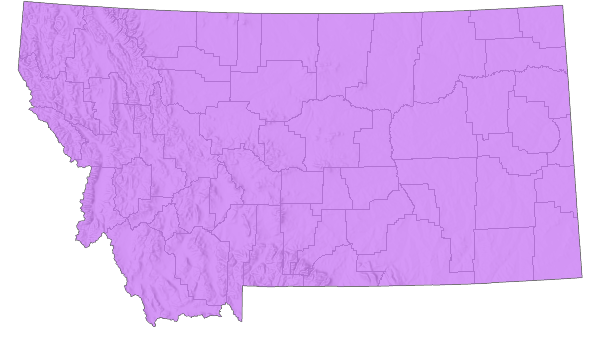
 Native
Native
Range Comments
The Red-shanked Grasshopper ranges from southern British Columbia, across the Prairie Provinces to Manitoba, and southward to southern Mexico. From west to east, eastern half of Washington, Oregon, and California, eastward to western Minnesota, angling southward through the western half of Nebraska, Kansas, Oklahoma, and Texas. In Montana, it has been reported for 21 counties (Otte 1984, Vickery and Kevan 1985, Pfadt 2002, Capinera et al. 2004, and Scott 2010).
Observations in Montana Natural Heritage Program Database
Number of Observations: 24
(Click on the following maps and charts to see full sized version)
Map Help and Descriptions
Relative Density
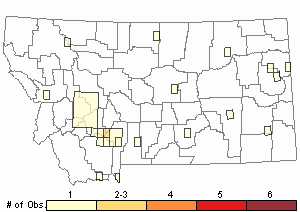
Recency
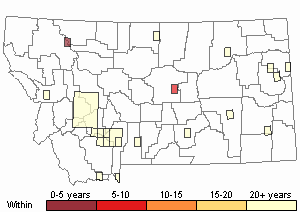

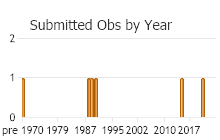
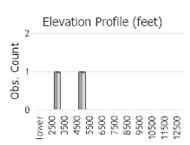 (Observations spanning multiple months or years are excluded from time charts)
(Observations spanning multiple months or years are excluded from time charts)
Habitat
This species inhabits grasslands of many types, shrub-grass communities, open areas in montane forests and vegetated areas above timberline up to 11,000 feet (Otte 1984, Vickery and Kevan 1985, and Pfadt 2002).
Food Habits
This species consumes exclusively grasses and sedges, such as
Western Wheatgrass (
Elymus smithii),
Needle-and-Thread (
Stipa comata),
Prairie Junegrass (
Koeleria macrantha),
Needleleaf Sedge (
Carex duriuscula),
Cheatgrass (
Bromus tectorum), and
Six-weeks Fescue (
Vulpia octoflora). In May, when
Blue gramma (
Bouteloua gracilis) becomes abundant, it becomes the preferred food of this grasshopper, and newly hatched nymphs feed on it heavily in late summer and early fall (Otte 1984, Vickery and Kevan 1985, Pfadt 2002).
Reproductive Characteristics
The following is taken from Capinera and Sechrist (1982), Otte (1984), Vickery and Kevan (1985), and Pfadt (2002). Courtship flight displays do not occur in this species. A courting male stridulates in a sequence of bursts using a single hind femur, striking an inner ridge against a series of nodes on the edge of the forewing. The bright red of his inner hind femur may also function as a visual attractant to the female. There have been no additional observations reported regarding courtship and copulation. The act of female egg laying has not been observed in the field, but evidence from lab studies with captive individuals indicate that she selects bare soil to oviposit her eggs, requiring one hour to complete, depositing eggs 2-3 inches deep. The egg pods collected were large, measuring 70 mm long and slightly curved, the bottom of the pod is enlarged 9-10 mm in diameter and contain 32 brown eggs, measuring 6-6.5 mm long. The top of the pod is filled with froth. In Montana, this species has a two-year life cycle, spending its first winter in the egg stage and its second as a partly grown nymph. This species passes through 5 or 6 instars in males, and 6 instars in females.
References
- Literature Cited AboveLegend:
 View Online Publication
View Online Publication Brooks, A.R. 1958. Acridoidea of Southern Alberta, Saskatchewan, and Manitoba (Orthoptera). The Canadian Entomologist (Supplement 9) 90:5-92.
Brooks, A.R. 1958. Acridoidea of Southern Alberta, Saskatchewan, and Manitoba (Orthoptera). The Canadian Entomologist (Supplement 9) 90:5-92. Brust, M.L, W.W. Hoback, and R.J. Wright. 2008. The Grasshoppers of Nebraska. Lincoln, NB: University of Nebraska Extension Service, APHIS.
Brust, M.L, W.W. Hoback, and R.J. Wright. 2008. The Grasshoppers of Nebraska. Lincoln, NB: University of Nebraska Extension Service, APHIS. BugGuide. 2003-2022. Identification, Images, & Information for Insects, Spiders & their Kin for the United States & Canada. Accessed 6 January 2022. https://bugguide.net/
BugGuide. 2003-2022. Identification, Images, & Information for Insects, Spiders & their Kin for the United States & Canada. Accessed 6 January 2022. https://bugguide.net/ Capinera, J.L. and T.S. Sechrist. 1982. Grasshoppers of Colorado: Identification, Biology, and Management. Fort Collins, CO: Colorado State University Experiment Station, Bulletin 584S. 161 p.
Capinera, J.L. and T.S. Sechrist. 1982. Grasshoppers of Colorado: Identification, Biology, and Management. Fort Collins, CO: Colorado State University Experiment Station, Bulletin 584S. 161 p. Capinera, J.L., R.D. Scott, and T.J. Walker. 2004. Field Guide to Grasshoppers, Katydids, and Crickets of the United States. Ithaca, NY. Cornell University Press.
Capinera, J.L., R.D. Scott, and T.J. Walker. 2004. Field Guide to Grasshoppers, Katydids, and Crickets of the United States. Ithaca, NY. Cornell University Press. Hebard, M. 1928. The Orthoptera of Montana. Proceedings of the Academy of Natural Sciences of Philadelphia, Vol. 80:211-306.
Hebard, M. 1928. The Orthoptera of Montana. Proceedings of the Academy of Natural Sciences of Philadelphia, Vol. 80:211-306. Helfer, J.R. 1971. How to Know the Grasshoppers, Crickets, Cockroaches, and Their Allies. Revised edition (out of print), Mineola, NY: Dover Publications.
Helfer, J.R. 1971. How to Know the Grasshoppers, Crickets, Cockroaches, and Their Allies. Revised edition (out of print), Mineola, NY: Dover Publications. Otte, Daniel. 1970. A comparative study of communicative behavior in grasshoppers. Miscellaneous Publications, Museum of Zoology, No. 141. Ann Arbor, MI: University of Michigan.
Otte, Daniel. 1970. A comparative study of communicative behavior in grasshoppers. Miscellaneous Publications, Museum of Zoology, No. 141. Ann Arbor, MI: University of Michigan. Otte, Daniel. 1984. The North American Grasshoppers Volume II. Acrididae (Oedipodinae). Harvard University Press. 366 pp.
Otte, Daniel. 1984. The North American Grasshoppers Volume II. Acrididae (Oedipodinae). Harvard University Press. 366 pp. Pfadt, R.E. 2002. Field Guide to Common Western Grasshoppers, 3rd edition. Laramie, WY: Wyoming Agricultural Experiment Station, Bulletin 912, modified by S. Schell and S. Schell for electronic publication. Accessed 19 February 2020. http://www.uwyo.edu/entomology/grasshoppers/field-guide/index.html#fieldguidetoc
Pfadt, R.E. 2002. Field Guide to Common Western Grasshoppers, 3rd edition. Laramie, WY: Wyoming Agricultural Experiment Station, Bulletin 912, modified by S. Schell and S. Schell for electronic publication. Accessed 19 February 2020. http://www.uwyo.edu/entomology/grasshoppers/field-guide/index.html#fieldguidetoc Richman, D.B., D.C. Lightfoot, C.A. Sutherland, and D.J. Ferguson. 1993. A manual of the grasshoppers of New Mexico. Las Cruces, NM: Cooperative Extension Service, Handbook No. 7.
Richman, D.B., D.C. Lightfoot, C.A. Sutherland, and D.J. Ferguson. 1993. A manual of the grasshoppers of New Mexico. Las Cruces, NM: Cooperative Extension Service, Handbook No. 7. Scott, R.D. 2010. Montana Grasshoppers, Katydids, and Crickets A Pictorial Field Guide to the Orthoptera. MagpieMTGraphics, Billings, MT.
Scott, R.D. 2010. Montana Grasshoppers, Katydids, and Crickets A Pictorial Field Guide to the Orthoptera. MagpieMTGraphics, Billings, MT. Vickery, V. R. and D. K. M. Kevan. 1985. The grasshopper, crickets, and related insects of Canada and adjacent regions. Biosystematics Research Institute, Ottawa, Ontario. Publication Number 1777. 918 pp.
Vickery, V. R. and D. K. M. Kevan. 1985. The grasshopper, crickets, and related insects of Canada and adjacent regions. Biosystematics Research Institute, Ottawa, Ontario. Publication Number 1777. 918 pp.
- Additional ReferencesLegend:
 View Online Publication
View Online Publication
Do you know of a citation we're missing? Anderson, N.L. 1962. Grasshopper-vegetation relationships on Montana grasslands. Ph.D Dissertation. Bozeman, Montana: Montana State University. 73 p.
Anderson, N.L. 1962. Grasshopper-vegetation relationships on Montana grasslands. Ph.D Dissertation. Bozeman, Montana: Montana State University. 73 p. Gillespie, R.L.1992. Dynamics of grasshoppers (Orthoptera: Acrididae) at a rangeland-crop interference. Ph.D. Bozeman, MT: Montana State University. 111 p.
Gillespie, R.L.1992. Dynamics of grasshoppers (Orthoptera: Acrididae) at a rangeland-crop interference. Ph.D. Bozeman, MT: Montana State University. 111 p. Hebard, M. 1932. Notes on Montana Orthoptera. Proceedings of the Academy of Natural Sciences of Philadelphia. V. 84. pp 251-257.
Hebard, M. 1932. Notes on Montana Orthoptera. Proceedings of the Academy of Natural Sciences of Philadelphia. V. 84. pp 251-257. Henry, J.E. 1969. Protozoan and viral pathogens of grasshoppers. Ph.D. Dissertation. Bozeman, MT: Montana State University. 153 p.
Henry, J.E. 1969. Protozoan and viral pathogens of grasshoppers. Ph.D. Dissertation. Bozeman, MT: Montana State University. 153 p. Larson, D.P. 1996. Evaluation of sweep sampling as a method for determining grasshopper community composition on rangeland. M.Sc. Thesis. Bozeman, MT: Montana State University. 92 p.
Larson, D.P. 1996. Evaluation of sweep sampling as a method for determining grasshopper community composition on rangeland. M.Sc. Thesis. Bozeman, MT: Montana State University. 92 p. McDaniel, B. 1987. Grasshoppers of South Dakota. Brookings, SD: South Dakota Agricultural Experiment Station, Bulletin TB 89.
McDaniel, B. 1987. Grasshoppers of South Dakota. Brookings, SD: South Dakota Agricultural Experiment Station, Bulletin TB 89. Mussgnug, G.L. 1972. The structure and performance of an adult population of Aulocara elliotti (Thomas) (Orthoptera, Acrididae) near Billings, Montana. M.Sc. Thesis. Bozeman, MT: Montana State University. 97 p.
Mussgnug, G.L. 1972. The structure and performance of an adult population of Aulocara elliotti (Thomas) (Orthoptera, Acrididae) near Billings, Montana. M.Sc. Thesis. Bozeman, MT: Montana State University. 97 p. Sater, S. 2022. The insects of Sevenmile Creek, a pictorial guide to their diversity and ecology. Undergraduate Thesis. Helena, MT: Carroll College. 242 p.
Sater, S. 2022. The insects of Sevenmile Creek, a pictorial guide to their diversity and ecology. Undergraduate Thesis. Helena, MT: Carroll College. 242 p. Skinner, K.F. 1995. Plant and grasshopper community composition: indicators & interactions across three spatial scales. M.Sc. Thesis. Bozeman, MT: Montana State University. 144 p.
Skinner, K.F. 1995. Plant and grasshopper community composition: indicators & interactions across three spatial scales. M.Sc. Thesis. Bozeman, MT: Montana State University. 144 p. Wachter, D.H. 1995. The ecology of selected grasshopper species along an elevational gradient. M.Sc. Thesis. Bozeman, Montana: Montana State University. 59 p.
Wachter, D.H. 1995. The ecology of selected grasshopper species along an elevational gradient. M.Sc. Thesis. Bozeman, Montana: Montana State University. 59 p.
- Web Search Engines for Articles on "Red-shanked Grasshopper"
- Additional Sources of Information Related to "Insects"





